Building a strong brand is essential for success in the casino industry in today’s competitive market. I have found that, no matter what the project, market, or budget, to be successful and rebrand for the long run, the steps are the same. They are what one of my former colleagues liked to call the “Jules Rules” of branding. Developed over ten years ago, I’m happy to say they still hold up. I even used them to guide my book Reel Marketing.
As a casino marketer, you know the importance of creating and maintaining an engaging brand. After all, it’s your primary tool to draw in existing and new guests and ensure they keep coming back! But what rules should you be following when managing your casino brand? In this post, we look at five essential rules every casino marketer should abide by to create a powerful and successful gaming brand. From understanding your target audience to integrating your brand into your operation, each one of these rules will help ensure that potential customers are attracted to your casino. Still, more importantly, they will realize a connection for years to come.
Brand Rule #1: Know Your Audience
Building an effective brand requires more than a logo or website design—it also takes getting to know your target audience. To create something that resonates with them, you must understand who they are, what they value, and what motivates them. This understanding will help you develop engaging events, promotions, and messages that can impact your casino’s success.
“The most successful brands are the ones that have a deep understanding of their target audience.”– Simon Sinek
Formal research unearths a great deal of insight. I always recommend it, but I also highly recommend spending time where your customers experience your brand — on the property and off.
Whether you’re a casino operator or a family-owned retail outlet owner, take time on your floor. Meet and learn more about your guests. Understand what your front-line employees face when trying to deliver on your brand promise. If you’re working with an agency, this is an excellent opportunity for your agency team to understand your business. It’s incredible what everyone will learn and how that will affect the next steps.
Today’s customers are making decisions using multiple channels. Understanding their needs and (perhaps unspoken) desires is critical to developing a brand that will resonate with them. At this point, consider the various categories of customers you have or want to have. A generic approach to your customer classification will lead to a generic approach to your brand.
Take the time to get to know your essential demographic and use your findings to inform how you communicate with them and the experience your brand essence can influence. It’s only through understanding who they are that you can honestly speak their language.
Brand Rule #2: Brands are Built from the Bottom Up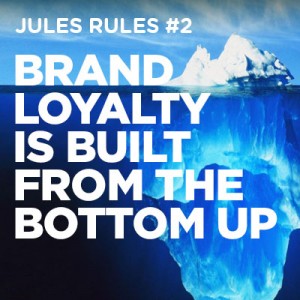
Brands are deceptively complex entities – what we see from the outside is limited to the identity, colors and graphics companies use to project. However, these are only superficial aspects of brands; like an iceberg, there’s far more beneath the surface. The most impactful parts of a brand have little to do with how it looks. They include core values, customer service, culture, and dependable messaging. A powerful brand holds these fundamental elements together to produce a robust and consistent impression on consumers over time, significantly outweighing mere aesthetics.
I have been known to use an iceberg image as a long-standing example of what makes a good brand because it’s the best way to show your operations team how what they do is an essential part of the brand. All the things that happen below the surface are what make your brand true (or not) to your guests and your employees. This reframing of a brand allows them to see themselves as powerful influences on the brand, whereas before, they may have assumed only marketing had influence,
In Jules Rules #1, we discussed how customers make decisions by interacting with many channels. Your customer validates their decision through multiple interactions with your brand. Whether that be how easy it is to find what they are looking for or how the cashier treats them at the sale, your brand is continuously sending a message. So, it’s crucial that the brand vision influences operations beyond a logo on a uniform.
What lies below the surface – company values and principles, customer service, employee engagement and more – are the elements of a brand that lay the foundation of how it appears to consumers through established relationships and perceptions. The higher levels of branding are also responsible for ensuring consistency in messaging, creating effective communications with customers, and delivering on promises consistently over time. These underlying parts shape our long-term perception of brands; therefore, casinos must understand this multi-level approach to successful branding to have a positive and lasting relationship with guests.
Brands are so integral to our lives that they often go beyond their visual identity. The next time you embark on a brand project, look at all those elements before giving your agency or graphic artist directions on a name or logo. Get this right, and a brand can expect long-term success and high consumer trust.
Brand Rule #3: Operationalize Your Brand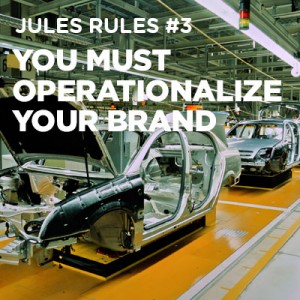
I’ve said this at least ten times in this post, but building and maintaining a successful brand is not only about designing an eye-catching logo, writing clever slogans, and launching a creative ad campaign. It is also about bringing the brand to life daily and making it meaningful. This process is known as operationalization, taking the brand beyond its visual identity and representing it in its conduct across all aspects of operations. To truly understand who your organization is and what it stands for from all angles, operationalizing your strategy and ethos through thoughtful deployment and implementation within operations will be essential. When you can’t see a difference between what you say you do (marketing) and what you (actually) do (operations), that’s when you know you have a great brand.
First, you must build an internal culture. As a leader, you must demonstrate the brand promise in everything you do. Then, you must ensure that the tools you provide your employees to deliver on the brand are consistent with your vision. If you promise a “family-like” experience, your employees must feel like they are part of that family first before they welcome guests. If your brand promises a fun atmosphere, team members must be able to bring that promise FROM the back of the house to the guest experience. In other words, your brand cannot come to life simply with the door opening from the employee clock to the floor.
The process of building a brand requires you to not only set a strategy and position but to “operationalize” it. More than a logo on a sign or an advertising campaign, operationalization is about how your brand becomes the organization’s culture. To quote Denise Lee Yohn, “It’s about putting your brand to use as a management tool — and getting the most value out of it.” In her book, What Great Brands Do, she points out, “by limiting the definition of your brand to this external, surface level, you fail to realize its full business value.” The brand becomes the driver of decisions because team members have internalized it more than just being communicated to employees. In effect, it allows your brand to come to life and enables you to deliver on the brand promise at every moment of the customer journey.
Companies must actively align the brand vision with the vision of the operation. However, Gallup’s recent State of the American Workplace report indicates that only 22% of U.S. employees strongly agree that their company’s leaders have a clear direction for their organization! Why? Because a small group of executives often decides the vision and purpose of the brand. This vision is then “pushed” down to the rest of the organization in various ways, from memos to pep rallies. The intention and hope are that it will become adopted. Still, the vision rarely achieves the buy-in we need because we must – but fail to – include a significant number of people as we shape the organization’s vision, purpose, and direction.
Studies have shown that large companies with solid branding integration into their operations tend to outperform those with separate marketing divisions; thus, the operationalization of the brand can be a critical factor in long-term success.
Brand Rule #4: True Branded Programs Share DNA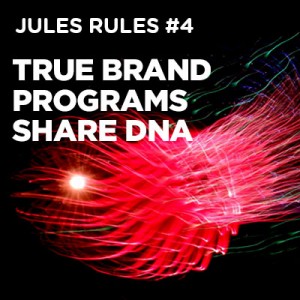
Brands, like people, have one-of-a-kind personalities that extend across touchpoints and employees. When true to their DNA – customers and staff will be most engaged with the brand’s offerings. While easy to become seduced by trends outside of your brand’s essence – these can often feel disjointed against its core values or promise, leading to inconsistent guest and team member experiences. The offerings you feature must feel like they are coming from the same source. You’re not a shopping center offering every option. You must be selective and only offer the things that make sense to your brand. To paraphrase Steve Jobs, sometimes what you say “no” to is as important as what you say “yes” to.
Having a shared DNA means that all brand programs are aligned regarding messaging, tone of voice, visual identity, and values. This alignment creates a recognizable and consistent brand experience for customers, which can increase brand recognition and loyalty. When a customer encounters a brand program that shares the same DNA as others they have encountered, they are more likely to recognize it as part of the same company, which can increase trust and credibility.
“Consistency in branding is key to building a strong brand identity.”– Martin Lindstrom
To build a trusted and valued brand, you must be authentic and transparent in your customer interactions. Brand trust is built through honesty about your products, services, and values and following through on your promises. Moreover, savvy consumers can spot inauthentic brands a mile away.
“Authenticity is the foundation of all great brands.”– Howard Schultz
Additionally, having a shared DNA can make it easier for companies to roll out new brand programs and initiatives because all new programs can be aligned with the existing brand DNA, reducing the need for extensive changes to the visual identity, messaging, or tone of voice. This alignment can save time and resources and reduce the risk of inconsistent branding.
Ultimately, sharing the same DNA is essential for brand programs to be effective and consistent. By having a shared DNA, casinos can ensure that their brand is easily recognizable, trustworthy, and consistent across all touchpoints. This can help to increase brand recognition, loyalty, and, ultimately, success.
Brand Rule #5: Make Your Brand Iconic
Iconic brands are not a flash in the pan nor relegated to the latest and most celebrated status. Iconic brands become symbolic of something more than a mere product. Google. IBM. FedEx. Coca-Cola. More than the products, these brands stand for emotional and psychological associations that drive customers to do business with them. When I was at the Isle of Capri and considering the company’s brand strategy, we found gold in a file cabinet (metaphorically speaking). Dusting off the Lady Luck brand, we found she had stood the test of time as perhaps the most iconic casino brand.
Many iconic casino brands have become synonymous with world-renowned gambling experiences. From the glitz and glamour of Las Vegas to the Art Deco elegance of Monte Carlo, these global gaming symbols offer visitors an unforgettable atmosphere. Even apart from the physical locations, several instantly recognizable casino brands have emerged through online gaming sites and mobile apps, making their mark as some of the most successful players in the industry. The ubiquitous presence of these household names indicates how influential they have become in shaping our understanding of modern casino entertainment.
From the Caesars, Wynn, MGM, Bellagio, Venetian, Flamingo, and (now) Horseshoe on the Las Vegas Strip to Foxwoods, Mohegan Sun and Seminole Hard Rock in the regional markets, iconic casino brands are found all around the United States. Each is impressive for its range of offerings, but more importantly, all understand the importance of the customer experience on the brand.
“The customer experience is the next competitive battleground.” – Jerry Gregoire.
In the casino industry, customer experience can make or break a brand. To build a positive brand reputation, you must focus on providing your customers with a seamless, enjoyable experience. This includes everything from the physical environment of your casino to the way your staff interacts with customers.
Building a solid brand in the casino industry requires a commitment to understanding your target audience, differentiating your brand, being consistent and authentic, and focusing on the customer experience. By following these five rules, you’ll be well on your way to creating a brand that stands out and resonates with customers.
“Your brand is the single most important investment you can make in your business.” – Steve Forbes
Branding is not a one-time task, and the Jules Rules can help to ensure your success for years to come. Not only will following these rules make your brand more successful, but it will also make operations more efficient and allow you to attract top talent.

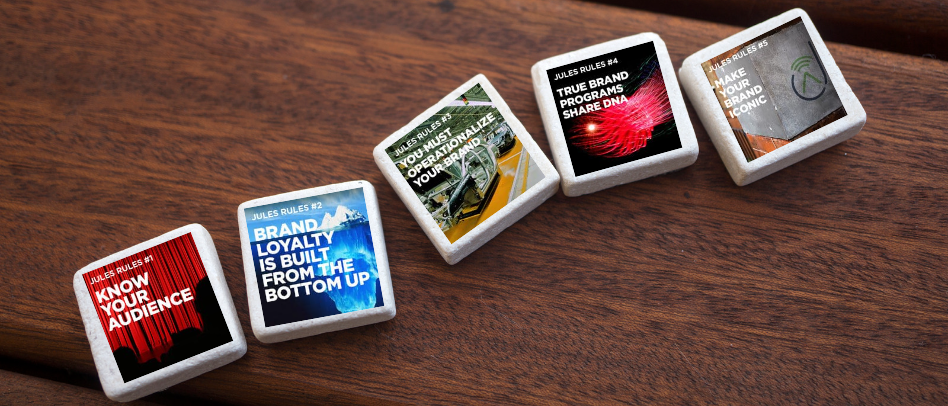

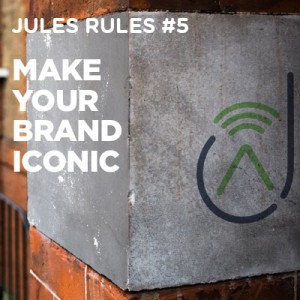
Recent Comments